
May every moment of the year to come be filled with the joys of all you hold dear.
Happy holidays from Mexico Cooks!.
Mexico: a culinary travelogue, an adventure for the palate, mind, and spirit.
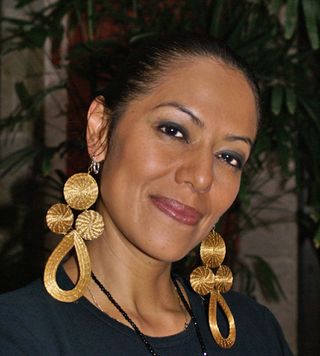
Lila Downs, Morelia, Michoacán, October 3, 2009. Unless otherwise noted, all photos are copyright Mexico Cooks!.
Lila Downs hypnotized Morelia and absconded with the city's heart a few weekends ago. For a time, we Morelianos forgot about la crisis económica, we forgot about la influenza H1N1, we forgot about the violent problems that have plagued our city for more than a year. We forgot everything except the essence of la Lila, who worked her black magic on all of us and captured our every sensibility with her voodoo moves and bewitching voice. In a jam-packed Morelia theater, for a couple of hours on a Sunday evening, Lila Downs gave us the gift of letting us remember our best selves.
Mexico Cooks! has watched Lila (pronounced LEE-lah) Downs grow as an artist since 2004. We first saw her perform in the patio of the University of Guadalajara's Escuela de Artes Plásticos, and again at the city's Teatro Galerías, then in a marvelous get-the-crowd-dancing open air concert in the Plaza de las Américas in Zapopan, and most recently this September in Guadalajara, where she opened her 2009 Black Magic Woman tour.
The tour, scheduled to run from August through November, started late because, as Lila said, "Me metieron un cuchillo…" ('They stuck a knife in me…'). Just before the tour was due to open in Denver, Lila had a different, unexpected opening: her appendix had to be removed.
A scant month after surgery, still looking a bit physically challenged from the procedure, Lila launched the Black Magic Woman tour at the sold-out Teatro Diana in Guadalajara. But oh boy, two weeks later in Morelia, Lila was back at the top of her form.

Lila Downs and her incredible troupe of musicians took the stage with a bang in Morelia and never let up.
Lila is the daughter of a Oaxacan Mixtec cabaret singer and a father from the United States who taught at the University of Minnesota. Raised in both Oaxaca (in the far southern mountains of Mexico) and Minnesota (in the far northern plains of the USA), Lila grew up conflicted by her roots in two worlds. Viewed as an exotically brown-skinned girl in north, known as the daughter of a gringo in the south, Lila herself barely knew where she fit in.

Photo courtesy Fernando Aceves and Lila Downs.
When her father moved to Southern California, her mother sent teenage Lila to live with him to finish high school. After high school, Lila returned to her mother's home in Oaxaca. While visiting them at their home, Lila's father died unexpectedly of a heart attack. Left alone with her Indian mother, bitter and angry that her father had disappeared from her life, Lila started college in Minnesota but dropped out prior to finishing her education. She stopped singing, although she had sung while growing up and studied voice in college. She drifted with the Grateful Dead, a Deadhead and latter-day hippie.

Pure energy, pure movement, pure voice: Lila Downs captivated everyone in her Morelia audience.
After a two-year mix of intensive psychotherapy and deep personal introspection, Lila returned to the University of Minnesota and finished a degree in voice and anthropology. Consciously or unconsciously, her studies mirrored both of her parents.
When she returned to Oaxaca after college, she finally discovered herself: rooted deeply in Oaxaca, profoundly influenced by the suppression and hardship suffered by Mexico's indigenous peoples, she composed. And she sang, for the first time in several years.

Lila! For a sneak peek at Lila in action, watch and listen to her perform La Cumbia del Mole.
In the mid-1990s, Lila met Paul Cohen, an East Coast saxophonist. They soon joined their lives and their careers to ponerse las pilas (put on the batteries) for huge success. Paul encourages her to keep exploring Mexico's music traditions: ranchera, bolero, ballads, and more. Lila's next CD, which she hopes will be on the market in 2010, will be a compilation of música ranchera, from the mariachi tradition.
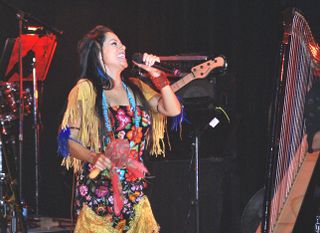
Joy and delight in Lila's music reverberated in every corner of Morelia's Teatro Morelos.
On Saturday night before the Sunday evening concert, Lila graciously received Mexico Cooks! for a little private conversation. We both wanted to talk about Lila's newest project, a musical theater version of Laura Esquivel's book, Like Water for Chocolate. Lila and Paul are writing nearly 20 original songs for the musical, songs that Lila hopes will endure long after the curtain closes on the play. Like Water for Chocolate will have a libretto by Quiara Hudes (In the Heights, running since early 2008 in New York), with creative direction by Jonathan Butterell (most recently, Fiddler on the Roof revival) and music direction by Ted Sperling (most recently, Guys and Dolls and South Pacific revivals). Lila expects the music to preview in concert in 2010 and hopes for an off-Broadway opening soon after that–and then to Broadway!

Book cover, Like Water for Chocolate by Laura Esquivel.
Like Water for Chocolate, published in 1989, is celebrating its 20th anniversary this year. There are nearly three million copies in print. When Like Water for Chocolate became a movie in 1992, it won all eleven of the Ariel awards (analogous to the Oscars) for that year.
"I'm really excited about this project." Lila drummed her fingers on the arm of her chair. "So many things about this story remind me of life in Oaxaca, even though the book is set in the north of Mexico. Like Water for Chocolate has already had such huge success as a book and a film! It's just made for the musical stage. The work is a tremendous opportunity for us."
Lila grinned when I asked if she likes to cook. "I do! I really do! My recipe for mole is fantastic! I love nopalitos (strips of nopal cactus, often served as a salad), and I love beans." She rolled her eyes and ducked her head. "My husband calls me a real beaner." She laughed. "Seriously, the fragrance of beans cooking, the flavor of the nopal–those are things that say 'home' to me. Those are the things that give me so much nostalgia. That's one of the reasons I love Like Water for Chocolate so much: home, love, and food are all mixed together. But you know that. That's what I believe, and that's what your Mexico Cooks! is all about, too: a Mexico that is home, love, and food."

Lila moves to deep rhythms and moves her audience to intense feelings. "Lila, te estoy queriendo!" shouts a fan. "Y yo a ti…" Lila responds from the stage, blowing a kiss. ('Lila, I am loving you!' 'And I am loving you…')
Lila Downs' life is a complex mix of intellect and feeling, tradition and the modern, of joy and pain, of hard work and well-deserved success. She gives exquisite voice to her deepest self, she offers unusual accessibility to her adoring fans, and she's made it to the top in a very harsh world. If you are ever in a place where Lila will be singing, get a ticket. Whatever the cost, it's worth every penny.
Qué viva Lila! Te estamos quieriendo…(Long live Lila! We are loving you).
Looking for a tailored-to-your-interests specialized tour in Mexico? Click here: Tours.
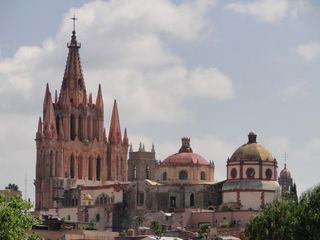
La Parroquia (Church of St. Michael the Archangel), San Miguel de Allende, Guanajuato. This church is one of the most-photographed in Mexico. Originally built in the late 1600s, the church facade was rebuilt close to the turn of the 20th Century. The architect, Zeferino Gutiérrez, had no formal training and patterned the church facade and towers after picture postcards of European cathedrals.
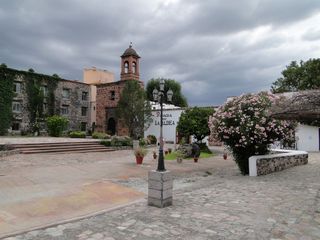
Entrance to Hotel Posada La Aldea, San Miguel de Allende. Los Cantantes del Lago stayed here during their time in town.
Exploring some of Mexico's historic sites was one of Los Cantantes' primary purposes in visiting the region around San Miguel de Allende. Dolores Hidalgo, Guanajuato–just half an hour from San Miguel–is known as la Cuna de Independencia, the cradle of independence. Standing on the steps of the historic church, Mexico Cooks! gave Los Cantantes a short history of Mexico's struggle for freedom from Spain.
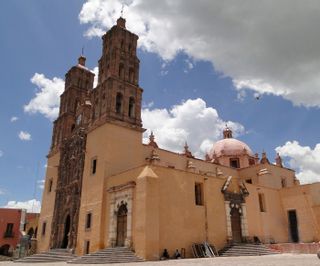
Templo de Nuestra Señora de los Dolores (Church of Our Lady of Sorrows), Dolores Hidalgo, Guanajuato. Padre Miguel Hidalgo y Costilla gave the Grito de Dolores (Cry from Dolores)–the call for independence from Spanish colonization–to his followers during the night of September 15, 1810.
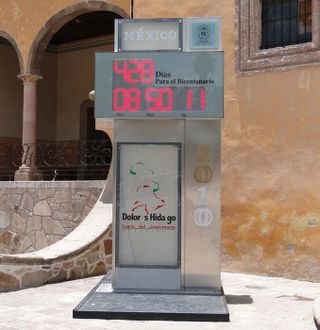
Mexico is preparing for its 2010 Bicentennial. This digital counter, positioned on the steps of the church where Hidalgo first gave the call for Mexico's freedom from Spanish rule, marks 428 days, eight hours, fifty minutes, and eleven seconds and counting, until the start of the bicentennial.
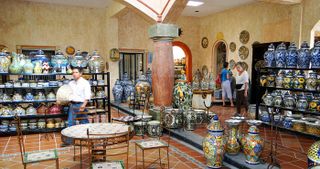
It wouldn't have been a trip to Dolores Hidalgo without stopping to shop for talavera, the colorful local pottery specialty. Los Cantantes surprised the fine workshop Arte San Gabriel with the large amount of talavera they bought and loaded onto the bus to take home.
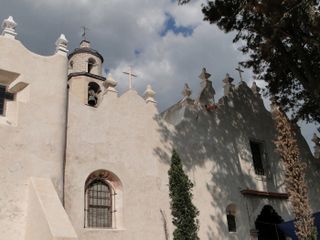
The Santuario de Jesús el Nazareno (Sanctuary of Jesus the Nazarene), Atotonilco, Guanajuato, was built in the 18th Century.
Los Cantantes del Lago scheduled two concerts in Guanajuato. Mexico Cooks! arranged for the first of the two, to be sung outdoors at the Santuario de Jesús el Nazareno to celebrate the beginning of the church's fiestas patronales, scheduled for the third weekend in July. As Padre Fernando Manríquez, the pastor of the Santuario, told me, "This concert is the perfect botana (appetizer) for the fiestas!"
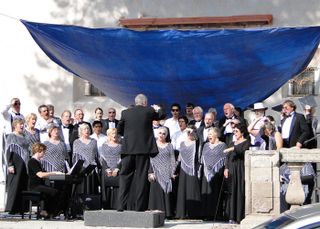
Los Cantantes sang in the atrium of the Santuario de Jesús el Nazareno.

The crowd attending the concert in Atotonilco was composed for the most part of people making a spiritual retreat at the church.
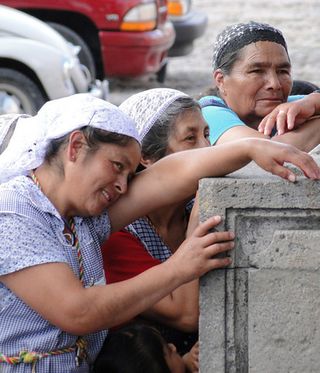
These women were completely enthralled by the singing. One elderly woman (not pictured) listened to parts of the concert with happy tears running down her cheeks.
The members of Los Cantantes del Lago were as profoundly touched as the audience was by the concert at the Santuario. It was impossible not to draw the comparison between the formal, elegantly dressed audiences that usually attend Los Cantantes concerts and this audience, many of whom had undoubtedly never heard a live concert of this type. One of the Cantantes said to me, "Here we are, out in the middle of nowhere, dressed in
our tuxedos and fancy gowns, singing for people who appear to be so poor. What must they think?" We agreed that it honored the audience that this marvelous chorus, dressed to the nines, came to sing for them.
As an encore, Los Cantantes sang the Mexican standard, Cielito Lindo. The entire audience sang along in Spanish to the song's chorus–you already know it:
Ay, ay, ay, ay, canta y no llores!
Porque cantando se alegran, cielito lindo, los corazones.
Oh, oh, oh, oh, sing and don't cry!
Because, little heaven, singing makes our hearts joyful.
How true the words are, and never brought closer to home than in this intensely emotional concert. In Atotonilco, glorious music made all of our hearts overflow with joy.
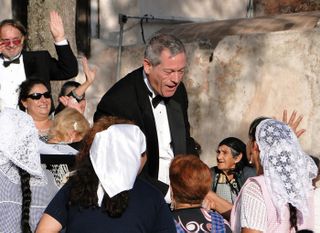
No one wanted the concert to end. As soon as the last encore was sung, the crowd surged forward to thank Maestro Timothy Welch and Los Cantantes del Lago for their visit to Atotonilco.
Los Cantantes del Lago sang the final concert of the Central Mexico Tour at the Teatro Ángela Peralta in San Miguel de Allende. A benefit for the Centro Infantil San Pablo, a program for needy Mexican children, the concert was a tremendous success.
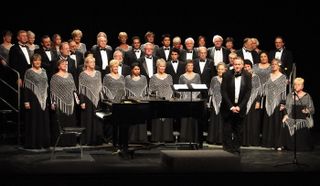
Final concert at the Teatro Ángela Peralta, San Miguel de Allende.
As the surprise finale to the evening, Maestro Tim auctioned off the only copy he had left of Los Cantantes del Lago's newest recording of Christmas music. The audience held its breath while the bidding went higher–and higher–and higher! Hammered down at over 2500 pesos, all the proceeds from the auction of that one CD went to the Centro Infantil San Pablo. Later in the evening, another audience member matched that bid as his personal donation to the school.
Filled with the memories of its warm reception wherever it sang during eleven days' travel through two states and countless towns, all done in two huge buses filled with singers, equipment, baggage, and new artisan purchases, Los Cantantes del Lago took to the road from San Miguel de Allende for the return home to Ajijic, Jalisco.
All photos courtesy of Robert Kelly. Robert, the designated photographer for Los Cantantes del Lago, has
posted many additional photos of the 2009 Central Mexico Tour in these files:
Looking for a tailored-to-your-interests specialized tour in Mexico? Click here: Tours.
Los Cantantes del Lago, invited to perform at the 9° Festival de Coros de La Inmaculada (9th Annual Choral Festival sponsored by the Church of the Immaculate Conception) in Morelia, combined their singing tour with a tour of churches and artisan villages in the states of Michoacán and Guanajuato.
Late last winter, Los Cantantes del Lago, a marvelous chorus based in Ajijic, Jalisco, (on the shore of Lake Chapala, Mexico's largest lake) contracted with Mexico Cooks! to plan, organize, and guide them during their Central Mexico Tour 2009. The members of the chorus, nearly all of whom live in the Jalisco municipality of Chapala, range in age from 18 to over 80. They are natives of countries as diverse as England, France, Canada, and the United States, as well as Mexico.
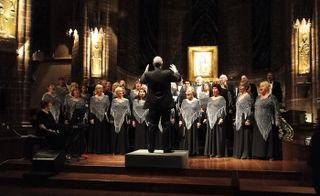
Los Cantantes del Lago, directed by Maestro
Timothy Welch, sang at the Santuario de Nuestra Señora de Guadalupe (Sanctuary of Our Lady of Guadalupe) in Zamora, Michoacán.
The chorus director, Timothy Welch, is a native of Wisconsin who has lived in the city of Guadalajara for the last 10 years. Under his direction, Los Cantantes del Lago have sung throughout Mexico, they have toured in Greece, Turkey, and Ecuador, and they have produced two recordings of multilingual Christmas music.
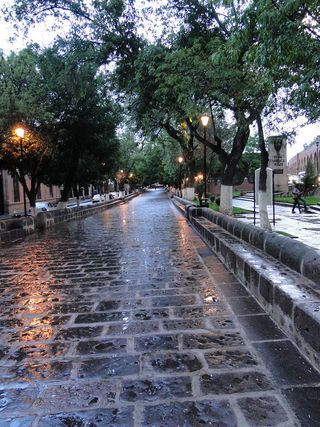
The Calzada de Fray Antonio de San Miguel is one of the most beautiful streets in Morelia. The tree-lined street runs from Morelia's Las Tarascas fountain to one of the city's 18th Century gems, the Santuario de Guadalupe.
For the last nine years, Morelia's Templo de la Inmaculada Concepción (Church of the Immaculate Conception) has hosted a choral festival. From its inception as a recital event for that church's chorus, the festival has grown into a vibrant and important showcase for choruses from all over Mexico. Hernán Cortés, director of the festival, invited Los Cantantes del Lago to participate in the 2009 Festival del Coro. The idea for Los Cantantes' Central Mexico Tour 2009 sprang from that invitation.

Bell tower, Templo de La Inmaculada Concepción, Morelia. La Inmaculada is the seat of Morelia's annual choral festival.
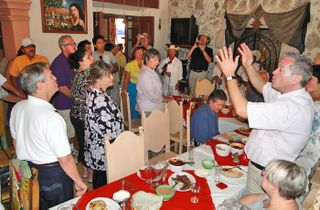
Los Cantantes del Lago enjoyed a marvelous welcome dinner at Morelia's Fonda Marceva. The magnificent Trio Los Caracuaros de Serafín Ibarra provided live music from Michoacán's Tierra Caliente (the hot inland lowlands). After the meal and in spite of being stuffed to the gills, Los Cantantes stood up and sang Pilgrim's Hymn from the opera The Three Hermits for the musicians who had been singing to them. Tim Welch directs in this casual setting.
Within the framework of the chorus's five concerts in Morelia and the surrounding region, Mexico Cooks! set up day trips to artisan villages and culturally important historical sites for Los Cantantes del Lago.
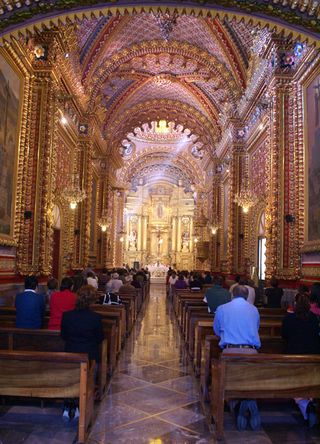
Morelia's Santuario de Nuestra Señora de Guadalupe (Sanctuary of Our Lady of Guadalupe). Although Los Cantantes did not sing at the Santuario, its beauty made
it a favorite destination during the week the chorus spent in Morelia. (Photo: Mexico Cooks!)
Los Cantantes visited various locations in Morelia, Pátzcuaro, and Cuitzeo, Michoacán. They were inspired by the restoration of the Ex-Convento de San Francisco de Ásis and shopped at the artisans' market in Tzintzuntzan. They were awed by the 16th Century Templo de Santiago Apóstol in Tupátaro.
After an afternoon touring Pátzcuaro, Michoacán, Los Cantantes sang at the Templo del Sagrario (Church of the Tabernacle), built in Pátzcuaro during the 17th Century.
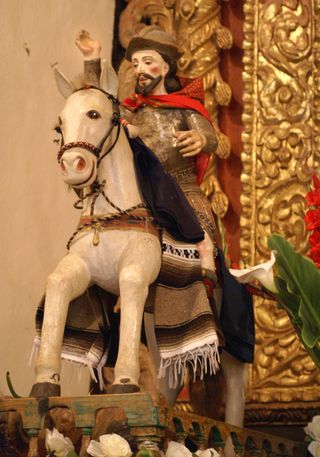
Santiago Apóstol (St. James the Apostle), the patron saint of the church at Tupátaro, Michoacán. (Photo: Mexico Cooks!)
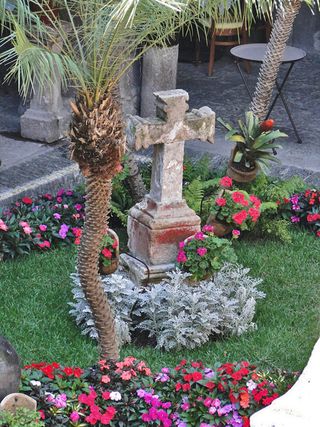
Los Cantantes del Lago stayed in Morelia at the Hotel de la Soledad. Public areas as well as guest rooms at the hotel are magnificently decorated and filled with flowers.
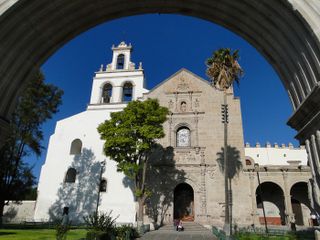
After their morning trip to Tupátaro, Los Cantantes sang in Cuitzeo, Michoacán, at the 16th Century Augustinian monastery dedicated to Santa María Magdalena.
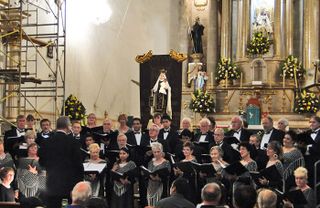
Despite ongoing restoration at the monastery in Cuitzeo, Los Cantantes del Lago squeezed in among the scaffolding and sang a beautiful concert.
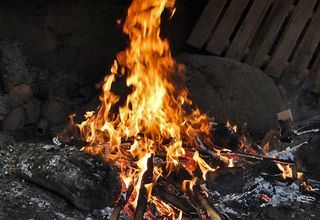
A hand-and-foot-powered bellows makes the fire leap high in the copper
workshop at Casa Felícitas in Santa Clara del Cobre, Michoacán.
Visiting the copper smiths of Santa Clara del Cobre was one of the highlights of Los Cantantes' week in Michoacán. Several of the singers took sledgehammer in hand to join the smiths in hammering a red-hot copper ingot at internationally known Casa Felícitas.
The real joy for Los Cantantes was meeting festival choruses from all over Mexico. All of the singing was marvelous! Beginning with the very first performance in Zamora, Michoacán, loud cheers and standing ovations followed every Los Cantantes' concert. It was the first time a chorus composed primarily of retired foreigners sang in the Festival del Coro, but it's not likely to be the last time.
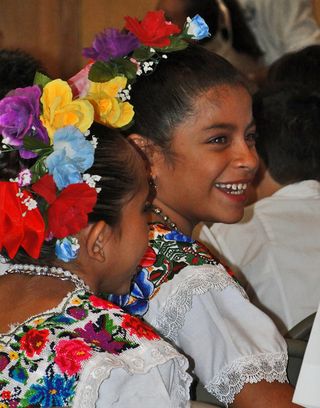
Joyous young chorus members from the Yucatán who also sang at the choral festival in Morelia.
The twelve invited choruses were so ecstatic with performing that even after their full week of performances in many different venues, after the long and beautiful closing Mass at La Inmaculada Concepción, they met one last time to sing a few more songs, just for one another.
Next week, travel with us as Los Cantantes del Lago leave Michoacán and head for San Miguel de Allende, Guanajuato. Please join Mexico Cooks! for the second leg of their 2009 Central Mexico Tour.
Except as noted, all photos are courtesy of Robert Kelly. Robert, the designated photographer for Los Cantantes del Lago, has posted many additional photos of the 2009 Central Mexico Tour in these files:
Looking for a tailored-to-your-interests specialized tour in Mexico? Click here: Tours.
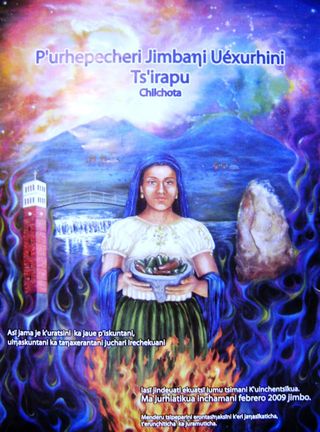
Poster advertising the P'urhepecha New Year celebrations in the city of Chilchota, Michoacán. Orquesta Janintserakua played at the festival.
Since the days before written history and since long before the 16th Century Spanish conquest of what is now Mexico, the Purhépecha indigenous people of Michoacán have had a profound impact on all things cultural in the region. Traditional Purhépecha textiles, clay work, metalwork, wood carving, dance, and music continue to be part of Michoacán's daily 21st Century life.
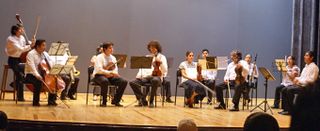
Orquesta Janintserakua of Morelia, Michoacán, onstage at the Auditorio del Centro Cultural Universitario.
The Orquesta Janintserakua, founded in 2003 by Juan Carlos Guerrero Jerónimo, is active in promoting the traditional pirékuas, sones abajeños and sones Purhépecha abajeños native to the Purhépecha of Michoacán. The orchestra takes pride in its strong musical presence both in the city of Morelia and in outlying towns across the state.
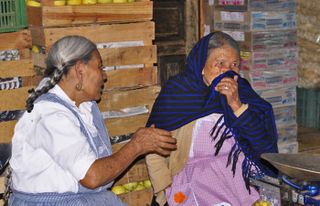
Old friends share gossip and a laugh at the Mercado Municipal in Pátzcuaro.
Music among the Purhépecha is an integral part of community life, both secular and religious. Pirékuas are most often highly romantic love songs, written and sung to woo a girl or to celebrate a couple's love. Sones, whether sones Purhépechas or sones Purhépecha abajeños, are generally lively dance tunes. Sones Purhépechas come from or are written about Michoacán's Zona Lacustre (lake zone) near beautiful Lago
de Pátzcuaro (Lake Pátzcuaro), or from the Meseta Purhépecha (the Purhépecha tablelands), in the foothills of nearby mountains. Sones Purhépecha abajeños originate in Michoacán's lowlands–the Tierra Caliente (Hot Lands).
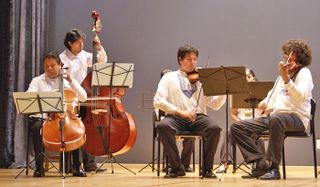
Oswaldo Rivas Sánchez, cellist, Danilo Gallardo Riveros on bass, Cristián Yaird Ponce Villanova and Victor Alfonso Zaragoza Rosales, both playing second violin. Hidden in the photo are other members of the Orquesta Janintserakua María Cristina Soria Pérez (saxophone), Juan Carlos Zamudio Anastasio (trumpet), and Carlos Campos Ramírez (trombone).

This iconic mask of the Purhépecha Danza de los Viejitos (Dance of the Little Old Men) is for sale in the Pátzcuaro market.
Some composers, especially Maestro Nicolás Bartolo Juárez, have also written sones purhépechas as anthems to the glories of nature.
For example, Maestro Bartolo composed a son purhépecha for each one of the six islands of Lago
de Pátzcuaro (Lake Pátzcuaro): Janitzio, La Pacanda, Jarácuaro, Yunuén, Tecuena,
and Urandén.
Among the most noted composers in the region are José María Ponce Martínez, Salvador Próspero Román, Francisco Salmerón Equihua, Eusebio González Tomás, Primitivo Alcántar Alejandre, José Alfredo Barrera Próspero, and Francisco Mercado Zacarías. All were or are prolific in various genres: vals, pirkékua, polkas, and sones.

Sara Patricia Ballesteros Lugo and José Luis Patlán Montero, first violins.
Juan Carlos Guerrero Jerónimo, the young director of Orquesta Janintserakua, spent his childhood and adolescence in his parents' Michoacán home town, Cherán. Beginning at age 11, he studied voice and violin with Maestro Francisco Mercado Zacarías in the Brigada de Desarrollo Indigena No. 15. At 15, he entered Morelia's Escuela Popular de Bellas Artes de la Universidad Michoacana de San Nicolás de Hidalgo, completing a Licenciatura en Música (similar to a bachelor's degree) with a specialty in composition.
In addition to composition, he has also studied directing techniques, clarinet, and saxophone. Only 37 years old, he has formed and played in several important musical groups. In 2003, he founded the Orquesta Janintserakua for the express purpose of preserving the musical works of Purhépecha composers.
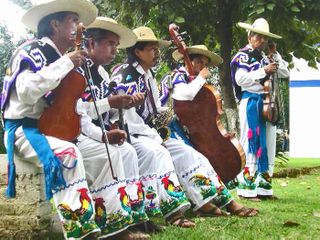
P'urhepecha orchestra in ropa típica (native dress) in Zacán, Michoacán.
The Orquesta Janintserakua is an important force in preserving the cultural heritage of more than a century of regional composers. Traditional regional music could easily be muscled out in present-day Michoacán by modern ranchera, banda, and grupero music.

José Luis Patlán, first violin: Monserrat Viridiana Magaña Arriaga, first clarinet; and Maestro Juan Carlos Guerrero Jerónimo, second clarinet and director of the Orquesta Janintserakua.
In 2008, the Centro de Investigación de la Cultura Purhépecha de la Universidad Michoacana de San Nicolás de Hidalgo produced and published Volumes 9 and 10 of the Antología de la Música Purhépecha (Anthology of Purhépecha Music), featuring Orquesta Janintserakua and Orquesta Tiamu Uricha. On the double-volume CD, both orchestras play the sones Purhépechas and the sones abajeños composed by Maestro Salvador Ramírez Várgas from the village of San Felipe de los Herreros, Michoacán. In the near future, Volumes 14 and 15 of the Antología de la Música Purhépecha will again feature music by Maestro Ramírez.
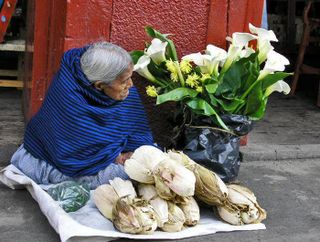
This elderly Purhépecha woman sells dried corn husks and alcatraces (calla lilies) on the street.
Maestro Ramírez was born in 1920 in Uruapan, where his family lived due to exigencies created by the Mexican Revolution of 1910. The family returned to San Felipe in 1930. Just a few years later, young Salvador joined his brother and other musicians in forming Orquesta Los Ramírez, which soon became sought after as one of the best of the region. Today, the Orquesta Los Ramírez is known as Orquesta Tiamu Uricha.
During his more than 70-year career as a composter and musician, Maestro Ramírez composed literally hundreds of sones and sones abajeños Purhépecha. Mexico Cooks! was privileged to be present at the concert in Morelia's Teatro Ocampo, where Maestro Ramírez received copies of Volume 9 and 10 of the recording of his music, produced by the university. Soon after that concert in his honor, Maestro Ramírez passed away and was buried in San Felipe los Herreros.
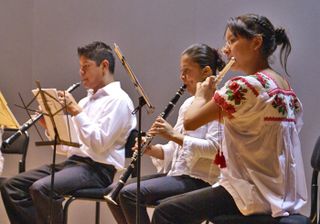
Carlos Antonio Campos Araiza, oboe; Monserrat Magaña, clarinet; Sofía Ivette Campos Araiza, transverse flute.
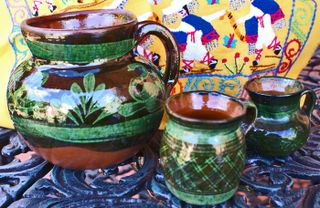
Traditional Purhépecha pottery from Tzintzuntzan.
Orquesta Janintserakua's members are primarily young musicians from Morelia's Escuela de Bellas Artes,
although several members are also members of the Orquesta Sinfónica de
Michoacán, which has its seat in Morelia. The orchestra takes
Michoacán's regional Purhépecha music wherever it's requested: to
regional town fiestas, to the state capital, and to outlying
districts. Its main goal is to spread the knowledge and enjoyment of this highly
idiosyncratic musical form.
Looking for a tailored-to-your-interests specialized tour in Mexico? Click here: Tours.
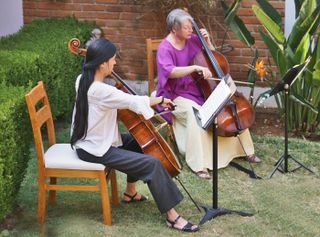
Irene Adriana Carrasco (Judy's cello teacher, foreground) and Judy, rehearsing in our garden, just before the guests arrived for Judy's mini-recital in April. It was a delightful evening spent among friends.
Living with a cello is lovely when its deep-voiced, sweet music pours out of the rehearsal room. Occasionally the tone is so beautiful that tears spring to my eyes. Living with a cello is not so lovely when the cello suddenly changes its tune, as Judy's did about six months ago. After a number of attempts to give the instrument a quick fix, she decided it needed more radical treatment. Her cello teacher, Irene Adriana Carrasco, recommended Maestro Alejandro Díaz Martínez of Violin Shop Querétaro, in the state of Querétaro, and offered to take Judy's cello to him for a consultation. A few days later, Judy and I visited Maestro Alejandro in his taller (workshop).
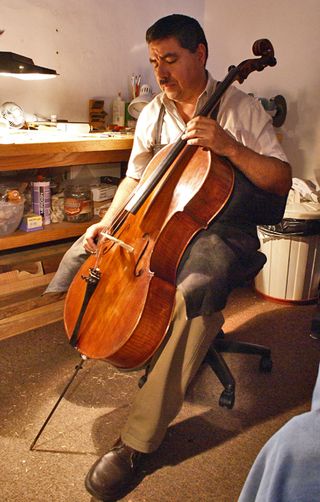
Maestro Alejandro Díaz with Judy's cello. Maestro Alejandro is a Morelia native with deep family roots here in the city.
With a twinkle in his eye, Maestro Alejandro recounted a bit of his history. "I liked the idea of studying architecture, of designing a building and watching it come to life. But I also liked studying music, especially the violin. When I was almost finished with my architectural studies, after three years at the Universidad de Michoacán de San Nicolás de Hidalgo, I had to switch. Some people thought I was crazy to quit my architectural studies when I was so close to finishing my degree, but it was something inside me that I could no longer deny: I had to study violin. It was a passion.
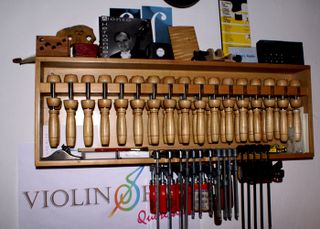
Clamps and other tools of the luthier's trade hang at the ready.
"I dropped my architectural courses and went to study violin at the Conservatorio de México in Mexico City. Fortunately my parents, the rest of my family, and my friends supported my idea. Four years of hard work were all worthwhile. I was honored to study with Arón Bitrán, one of the founders of the Cuarteto Latinoamericano. My grades were good and I loved to play, but something new was happening to me. I discovered another path, that of the laudero (luthier): building and repairing stringed instruments. It was risky to take yet another direction, but it was so fascinating! And in some ways, laudería combined my love of architecture with my love of music. It made sense to me, and once again, with the help of some friends, I made a new decision.

One of Maestro Alejandro's several work benches. It may look disorganized, but he knows exactly where to find what he needs.
"In 1985, I was studying violin for six hours a day, then studying for six hours a day at the taller de laudero (luthier's workshop) with Maestro Luthfi Becker, who specializes in Baroque instruments. I built my first violin during that same year, and I graduated in 1987 with six others, the first generación de lauderos (luthiers' graduating class) in Mexico City.
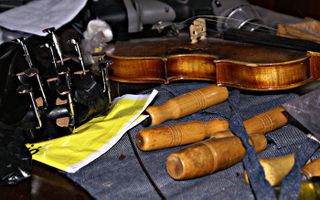
A violin in process of repair.
"In 1992, I came to Querétaro, where the Instituto de Bellas Artes in Mexico City founded the Escuela de Laudería in the mid-1950s. In 1993, I started teaching at the school, and I've been giving classes here for 16 years. I have nine students right now. They're studying the full course that leads to licenciatura (similar to a bachelor's degree) in laudería.
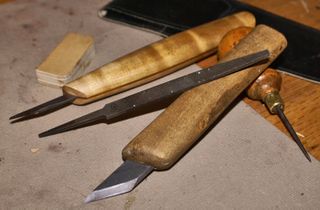
Various tools for cutting, piercing, and sanding new parts for stringed instruments.
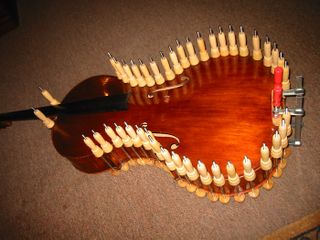
Maestro Alejandro removed the top of the cello, made and replaced the bass bar, and re-glued the top. He kept the top clamped until the glue was thoroughly dry. Photo courtesy Alejandro Díaz.
"Learning laudería requires tremendous discipline. It's not just about patching up an instrument that needs repair, using any wood you happen to have on hand. The course consists of ten semesters and includes studies in everything from the biology of wood to the history of instrument building. For example, when I looked inside Judy's cello, I could tell the age of the trees used in its construction–by the rings of the wood. I could see the type tree the wood came from, and I can tell you exactly where those trees grow. I could also approximate the age of the wood itself, when it was used to
build the cello.
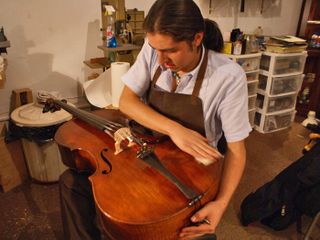
Erick Iván Díaz Garcia polishes Judy's cello. Erick has studied with Maestro Alejandro for two years. The long program of studies for luthiers at the Universidad Autónoma de Querétaro is unique in Mexico.
"One of the joys of laudería is receiving an instrument, whether an ancient violin or a late-20th Century cello like Judy's, and bringing it to its fullest expression of tone, resonance, and beauty. The instrument that still gives me chills when I think of its restoration is an 18th Century violin that came to me in dire condition. The 'stomach' of the violin was sunken, the bridge feet were dug into the top of the violin. Little by little I used my skills–traditonal skills as well as inventions that I thought up to overcome the obstacles of the violin's condition–and slowly brought the instrument back to life. The violin's owner, Cathy Meng Robinson of the Miami String Quartet, insists that the quality of the instrument since I repaired it is better than a Stradivarius violin that she owns.
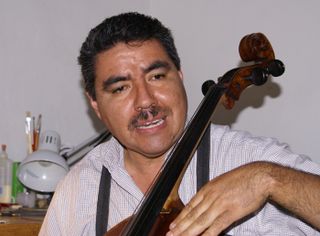
Maestro Alejandro explains a fine point of cello repair.
"Lauderos in other parts of the world–in the United States, for example–would like me to go work in their talleres, even take ownership of their workshops. But how could I? Here in Mexico, there are so few of us, maybe 100 fully trained lauderos. I have the responsibility and the joy to teach the lauderos of the future, and to rescue the instruments of the past. Here in Mexico, I have such a full life: my family, my work, my students. Compared to the fullness of my life right now, what could more money, the money people in other countries promise me for my work, give me? My son is 15; he studies violin and will soon study with me to follow in my footsteps. My daughter is only nine; her future is yet to be told. Laudería gives me the chance to know the world, from the United States to Canada to Cremona. And look–I've just begun, and already happiness fills my life."
Contact
Alejandro Díaz Martínez
Violin Shop Querétaro
Calle Ángela Peralta#19
Centro Histórico
Santiago de Querétaro, Guanajuato
Tel. 01.442.243.1488
Cel. 044.442.136.9128
Looking for a tailored-to-your-interests specialized tour in Mexico? Click here: Tours.

Sweetheart, you are my passion–I love you!
Mexico Cooks! celebrates its second anniversary this week. Two years seems on the one hand to be just a blink in time. On the other hand, we feel like we've known you forever. This week is a rerun of some of our favorite photographs, along with links to the posts where they originally appeared.
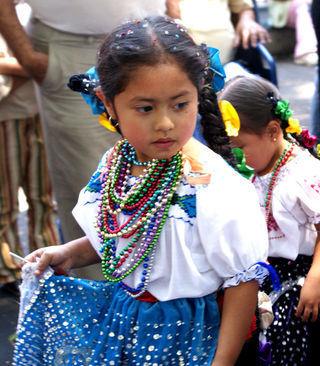
This beautiful child from Uruapan, Michoacán, originally appeared on April 14, 2007.
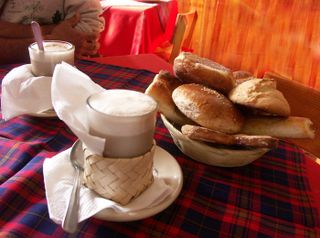
Pan dulce mexicano (May 5, 2007) is one of Mexico Cooks! most-viewed photos.
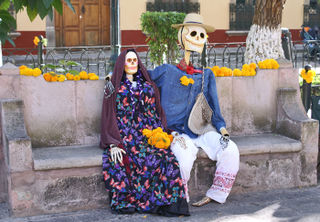
Day of the Dead in Morelia (November 24, 2007).

Tamales, tamales, and more tamales! December 22, 2007. The blackberry tamales in the photo are sweetly delicious for dessert or breakfast.
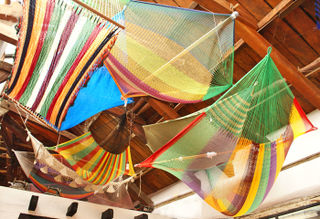
Hammocks swinging in Chiapas, April 12, 2008. Several weeks before and after this date were devoted to San Cristóbal de las Casas and its surrounding area.
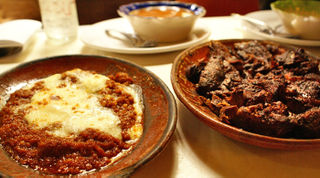
The three-article series about Mexico Cooks!' adventures in Guadalajara with the newspaper El Mural (June 21, 28, and July 5, 2008) was filled with recipes and fun.
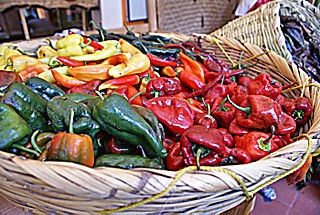
The Feria del Chile in Queréndaro, Michoacán. We'll be going back in August or September 2009.
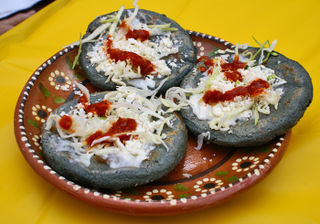
Mexico Cooks! is already eager for the VI Encuentro de Cocina Tradicional de Michoacán–and it's not until December 2009. Revisit the V Encuentro, held in December 2008, for a taste of what's to come.
We're so greatful to all of Mexico Cooks! readers. From the first article in February 2007 to the honor of being named #1 Food Blog in the World by the illustrious Times of London, you've given us your time, your loyalty, and your comments. The next year will be filled with all the best of Mexico–because, we all know, Mexico Cooks!
Looking for a tailored-to-your-interests specialized tour in Mexico? Click here: Tours.
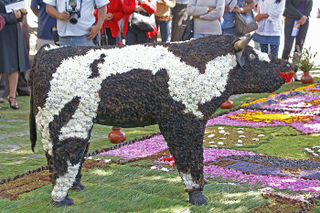
Standing at the entrance to the tapetes florales (floral carpets), this little cow made entirely of flowers and other plant materials welcomed visitors to the inauguration of Morelia's 20th Annual Festival Internacional de Música (International Music Festival).
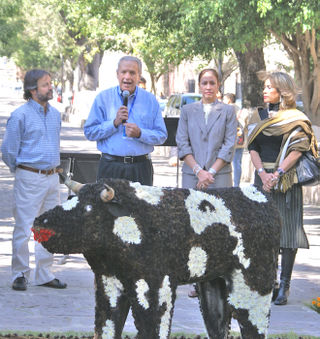
Dignitaries from Argentina (Gustavo Souto, far left) and Mexico (Miguel Bernal Macouzet and Magdalena Ojeda Arana, second and third from left) introduced the tapetes florales.
For two weeks each November, Morelia hosts an exciting international music festival with a particular country or region as its honored guest. In 2007, the guest of honor was the European Union. The guest of honor for 2008 is Argentina. Strains of Argentine folk music and the sensual tango have echoed in Morelia's concert halls and public plazas since the festival opened on November 15. It's easy to notice the music lovers who come from all over Mexico and from numerous other countries: after two weeks, we're all desvelados (sleepless) and a little groggy after the chance to attend more than two dozen concerts in the space of two weeks.
If you'd like a look at last year's festivities, you'll enjoy what you read here.
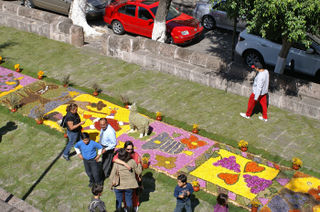
The tapetes florales are laid out along two blocks of Morelia's Calzada Fray Antonio de San Miguel, from the Fuente de las Tarascas to the Santuario de Guadalupe. This photo offers an idea of the dimensions of each segment of the construction. Each of the panels is approximately two meters wide by three meters long.
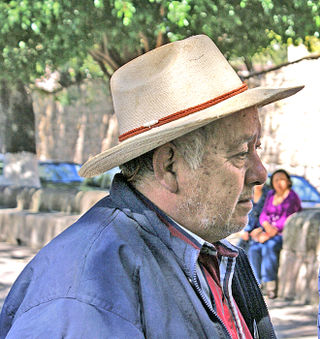
Maestro Neftalí Ayungua Suáres heads up the dozens of Patamban artisans who come to Morelia to create the floral carpets.
Mexico Cooks! loves music of many kinds and avidly looks forward to each November's festival. We've heard glorious concerts this year. However, our favorite part of this grand event happens not in the concert halls, not in the glittery mid-autumn Morelia nights, but on the morning of the festival opening. The tapetes florales (floral carpets), laid out during the night by Maestro Neftalí Ayungua Suáres and his teams of dozens of artisans from Patamban, Michoacán, appear as if by magic along Calzada Fray Antonio de San Miguel, one of Morelia's most charming walking streets.
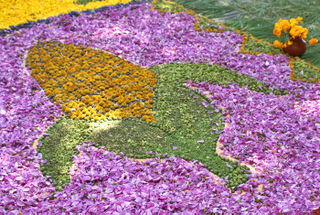
A mazorca (ear of corn), framed by bougainvillea flowers and flanked by a jar of cempasúchiles (marigolds).
Detail of the clay and floral guari (the P'urhepecha word for woman) figure made by Maestro Neftalí and his son.
This year for the first time, vertical figures made of clay and plant materials dot the tapetes florales. The large bunch of flowers the guari (above) holds are chrysanthemums and wild orchids. Her necklace and earrings are made of tejocotes (a fall/winter fruit similar to crab apples).

A rabbit made of two kinds of chrysanthemums and petals from the white mirasol (wild cosmos) flower.
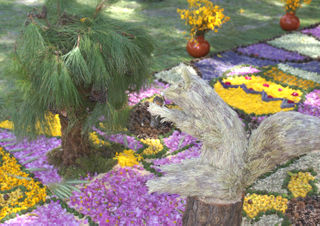
This figural piece is a little pine tree and a squirrel, munching on a pine cone while sitting on a stump.
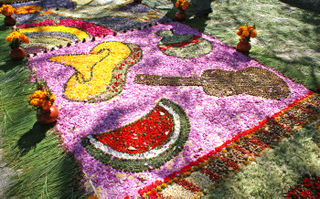
Mexican themes: a slice of sandía (watermelon), a huge sombrero (hat), a colorful olla (jar), and a guitarra (guitar).
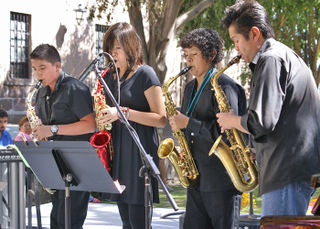
A variety of young music students, including this saxophone quartet, entertained us while we enjoyed walking alongside the tapetes on the Calzada. Dappled sunshine, clear air, and delicious fall temperatures made for a beautiful day.

This flower is made of acorns, flower buds, and aserrín (sawdust).
Looking for a tailored-to-your-interests specialized tour in Mexico? Click here: Tours.
Mexico Cooks! has been around the manzana (city block) a time or two since first living in Mexico nearly 30 years ago. Over all of that time, we've found a lot of hidden wonders in this vast República.
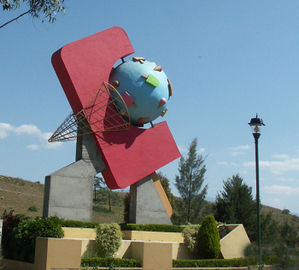
A huge popsicle marks the entrance to this way-off-the-beaten-path town. Why? We can take you there to find out!
In the "ABOUT" section listed on the front page of Mexico Cooks! (up there in the right-hand corner, where it's easy to miss), I make mention of the highly personalized tours I occasionally give for small groups. Many of my readers have asked about planning a Mexico Cooks! tour for themselves and their friends. Today, I've succumbed to your requests for more information.
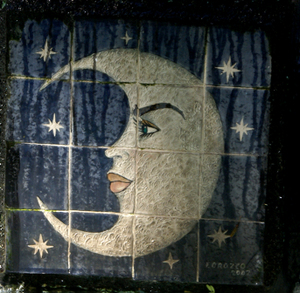
This pale and placid moon graces a lovely fountain–but where, why is it special, and how do you find it?
Minimum group size is two people, and I can accommodate up to seven tour participants for a day trip, a few-days' trip, or a longer adventure.
All of the tours that I offer include the following:

Mexico Cooks! knows the secret of this private chapel and will share it with you.
Tour participants pay individually for:

You can discover the joyous heart of Mexico with Mexico Cooks!
The myriad wonders of Mexico are too many to count, and too many to see in an entire lifetime. If you've been here and want more, the "more" that most tourists never see, Mexico Cooks! will meet your needs. Traveling with Mexico Cooks!, you have the opportunity to tailor-make the tour you want. Nothing is pre-packaged. Each itinerary is designed based on your ideas, your wants.
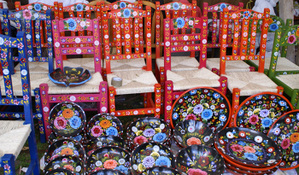
Colorfully beautiful, whimsical, or elegant, Mexico Cooks! knows where to find the best of Mexico's crafts. Come along…
If you have particular interests (artisan villages and handwork, churches and cathedrals, city and country markets [with or without a cooking class!], traditional Mexican food and ingredients in all their regional varieties, restaurants small and large, special fiestas and religious celebrations, and small regional museums, to list a few), Mexico Cooks! can show you more than you've dreamed of finding.
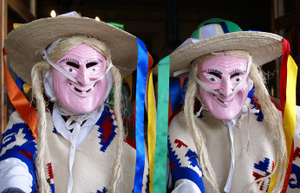
Who ARE these guys, and why are they smiling? We'll go see!
Most of the Mexico Cooks! tours are focused on Mexico's high-altitude Central Highlands, where the weather is nearly always temperate: balmy and sunny during the day and refreshingly cool during the evening hours. The best times for touring are mid-June through February. March through late May are often uncomfortably warm and dry for daytime touring. Come discover the cool joy of central Mexico in the summer.
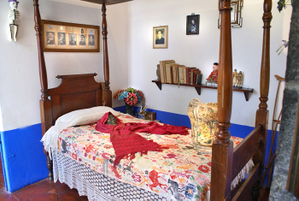
Mexico Cooks! can take you right into the bedroom of the all time best-known Mexican artist.
This is the perfect time to start planning a Mexico Cooks! tour. Email me at patalarga@gmail.com and tell me what you might like to do, or ask me for suggestions based on your interests. I'll be happy to quote prices and any other details you need.
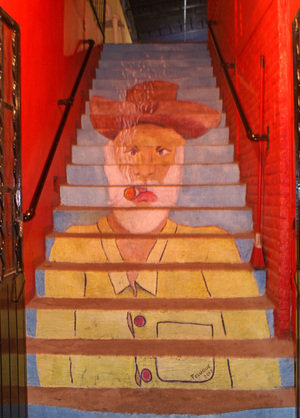
What a great staircase! Want to see it in person? We'll take you there.
Buen viaje–Mexico Cooks! te espera! (Have a great trip–Mexico Cooks! is waiting for you!)
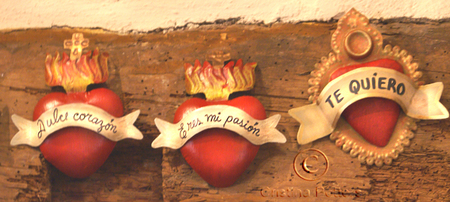
During the first week of April, Mexico Cooks! traveled with a group of friends to Michoacán's Zona Lacustre (Lake Zone). Our trip had three purposes: to taste every regional food specialty we could find to eat, to attend an enormous annual Michoacán-only artisans' fair, and to enjoy one another's company to the fullest. The trip was a huge success on all three counts.
Come to the artisans' fair opening day parade with Mexico Cooks!
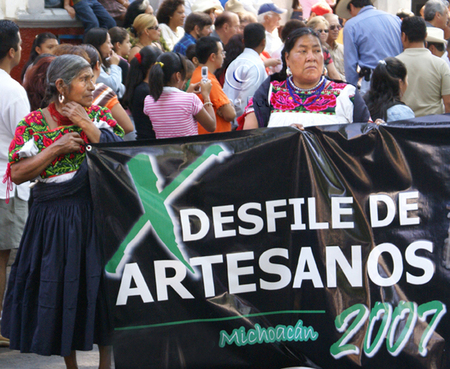
Parade of Artisans, 2007. Most of the many Purhépecha (the indigenous group of Michoacán) villages in the Zona Lacustre specialize in a particular form of artesanía (arts and crafts). The annual Feria de Artesanía opens as representative artesanos (artisans) from each village parade through the fair site. Each town delegate proudly bears a placard emblazoned with the town name. All along the parade route, some of the artisans carry stellar examples of their work.
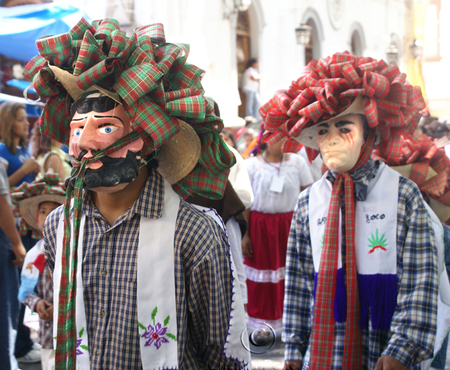
Ribbons and masks from Tócuaro.
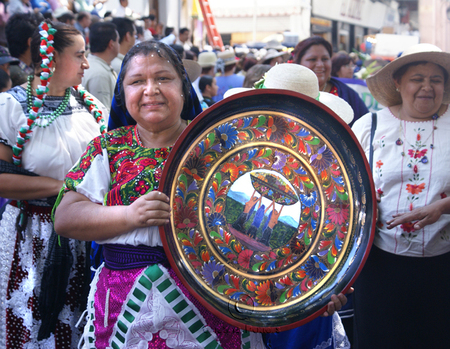
A Purépecha woman from Uruapan, vestida de gala (dressed in her finest) and speckled with festive confetti, shows off an example of fine maque (regional lacquerware).
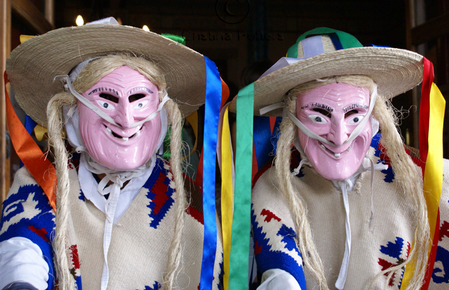
Dance masks, Danza de los Viejitos (the Dance of the Little Old Men).

Young Purhépecha women festooned with beads, lace, velvet, and ribbons. The baskets they carry are filled with confetti, ready to be tossed at the spectators. The young woman in red stopped directly in front of me, grinned, and showered me with color from head to toe.
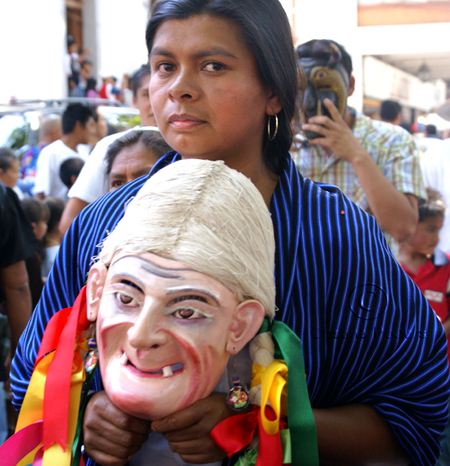
This beautiful young woman danced with her face covered by the mask of a toothless grandmother, wearing typical ribbons in her long white braids.
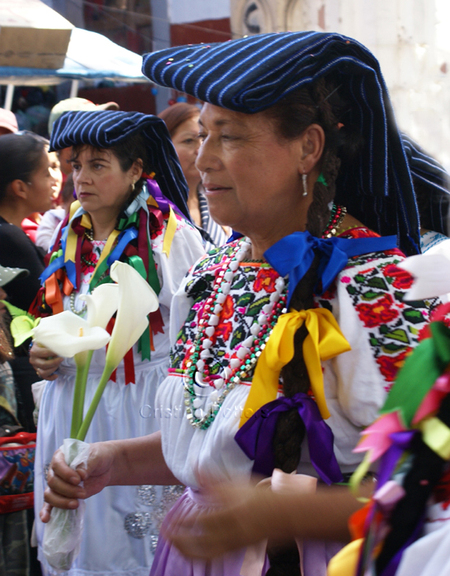
Purépecha women in Michoacán's Zona Lacustre ordinarily use a region-specific blue and black striped rebozo (shawl). Legend has it that this traditional style rebozo became popular in Colonial times: the black stripe symbolizes Spanish hair, the blue stripe symbolizes the Spanish eye. In daily life, the rebozo is utilitarian. Mothers use it to carry their babies slung on their backs, to carry wood for the kitchen stove and other burdens, and for simple warmth. Folded and placed on the head, the rebozo protects from the sun and balances pots and jars.
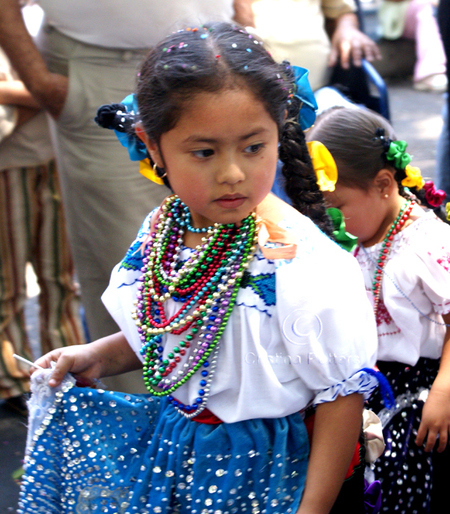
Beauty, tradition, and personal pride hallmark the Feria de Artesanía. One of Mexico Cooks! dearest friends says, "Cada que veo tus fotos siempre me dan la cara de volver." 'Every time I see your pictures, it always make me want to come back.'
In just a few days, we'll show you some of the incredible meals Mexico Cooks! ate along the way. We'd like to invent a scratch-and-sniff computer monitor to give you all but the taste of regional cooking. We're sure the photos will make your mouth water.
If you'd like to travel to the 2008 Feria de Artesanía in Michoacán, contact Mexico Cooks! and we'll start now to make your plans for adventure.